
HOME
INTRO
SYMBOLS
ALMANAC
ECONOMY
GEOGRAPHY
STATE MAPS
PEOPLE
FORUM
NEWS
COOL SCHOOLS
STATE QUIZ
STATE LINKS
BOOK STORE
MARKETPLACE
GUESTBOOK
CONTACT US


You may double left-click on a word on this page to retrieve its definition. Tweet Follow
New Jersey State American Folk Dance
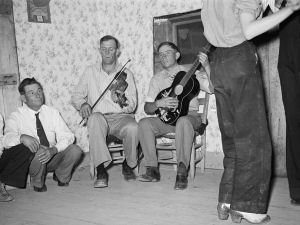
Traditional Square Dance Musicians
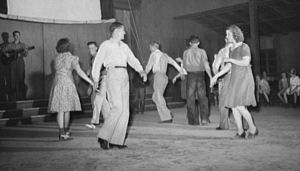
Saturday Night Square Dancing (1942)
Regarding New Jersey's efforts to adopt the square dance as its official state folk dance, we think it's important to know a little bit about similar activity on a national level to gain a greater understanding at the state level. A brief description of endeavors to declare the square dance the national folk dance of the United States of America can be found here.
The adoption of the square dance as the official American folk dance of New Jersey was not an overnight endeavor. In fact, the process began in 1979 when Nan & Frank Habersberger became presidents of the Northern New Jersey Square Dancers Association, Inc. (NNJSDA) in June of that year.
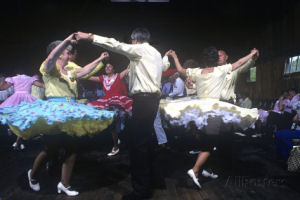
New Jersey State American Folk Dance: Square Dance
Posters and Photographs
The Habersbergers made declaration of the square dance as the official dance of New Jersey one of their early priorities. Coordinating the effort were 3rd Vice-Presidents Gabe & Sila Dell'Angelo and advisors Frank & Helen Cavanaugh who spearheaded a drive to distribute petitions, throughout the State of New Jersey aimed at naming the square dance the state's official folk dance.
In 1980 two resolutions were introduced in the New Jersey Assembly; one by Assemblyman David C. Schwartz and another by Assemblyman James Bornheimer. Both resolutions languished in committee prompting a meeting of four state square dance organizations; Northern New Jersey Square Dancers Association; Central New Jersey Square Dancers Association; and the Bucks-Trenton and Penn-Jersey Divisions, New Jersey based divisions of the Federation of Delaware Valley Square and Round Dancers.
In early May 1980, these organizations, sensing that more concerted action was needed to move a resolution out of committee and onto the Assembly floor for a vote, formed a coalition to accomplish that goal. Frank and Helen Cavanaugh were appointed to represent the square dancers and monitor their programs.
The Callers Council of New Jersey and the Northern New Jersey Round Dance Leader's Council lent their support.
The Cavanaughs organized a massive letter writing and public relations campaign targeting all New Jersey Assemblymen and Senators. Committee members were specifically addressed, urging quick action to move Assembly Joint Resolution No. 29 to the floor of the Assembly for a full vote.
The concerted effort by the square dance organizations, led by Frank and Helen Cavanaugh, was able to move Assembly Joint Resolution No. 29 to a floor vote where it was passed and forwarded to the Senate for consideration. But that's as far as it went during the 1980-1981 Legislature.
Frank and Helen Cavanaugh were persistent, however, and led the charge into the 1982-1983 Legislative Session.
SENATE JOINT RESOLUTION No. 1
A Joint Resolution designating the Square Dance as the American Folk Dance of the State of New Jersey.
WHEREAS, Love of State and professions is enhanced by traditions that have become a part of our way of live and the customs of the American people; and
WHEREAS, We have distinctive and meaningful symbols of our ideals in our State's flag and in many cultural endeavors, but no official designation of a State Folk Dance; and
WHEREAS, The Square Dance, which was first associated with the American people and recorded in history since 1651, has consistently been the one dance traditionally recognized by the American people as a dignified and enjoyable expression of American Folk dancing; and
WHEREAS, Official recognition of the Square Dance will enhance the cultural stature of New Jersey both nationally and internationally; and
WHEREAS, National and international prestige is in the best interest of all Americans; now, therefore,
BE IT RESOLVED by the Senate and General Assembly of the State of New Jersey:
1. The dance known as the Square Dance is designated the American Folk Dance of the State of New Jersey.
2. This joint resolution shall take effect immediately.
Approved January 19, 1983.
Success!
Joint Resolution No. 1 was approved by the New Jersey State Legislature on January 19, 1983.
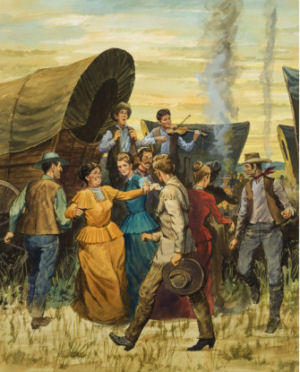
New Jersey State American Folk Dance: Square Dance
Posters and Photographs
The New Jersey Legislature has this to say about the state's official American folk dance:
"Do-si-do" and "swing your partner!" cries the caller in New Jersey's official State American Folk Dance, the square dance. In the popular American square dance, a caller shouts out directions to the dancing couples. Square dance music is lively and the dancers wear colorful clothes. New Jersey adopted it as our State American Folk Dance in 1983.
("State American Folk Dance")
May 19, 1983 was a day for celebration and dancing in the street.
The street in front of the New Jersey State Capitol in Trenton was closed off by State Police from 12:00 Noon to 2:00 P.M. while dancers from all over New Jersey came to celebrate. They were joined by Governor Thomas Kean in support of the legislation.
The 1980 coalition illustrated a need for an umbrella organization for the various square dance clubs throughout the state. In October, 1983, eight months after the square dance was named the American folk dance of the State of New Jersey, the Square Dance Council of New Jersey that would emerge; its mission was "to preserve and promote the square dance activity throughout the State and surrounding areas."
Frank and Helen Cavanaugh were named chairmen of the new organization.
The square dance is a popular type of folk dance in the United States. This dance for four couples, or groups of four couples, is performed in a compact framework of a square, each couple forming a side. Traditionally accompanied by a fiddle, accordion, banjo and guitar, the couples perform a variety of movements prompted by the patter or singing calls (instruction) of a "caller". Cooperative movement is the hallmark of well-executed square dancing.
Square dancing is to be distinguished from related dances called contra or longways dance where couples stand double file in a line and from round dances where couples stand in a circle. The origin of the square dance can be traced to English derivation and to the stately French cotillion performed in square formation that was popular at the court of Louis the fifteenth later replace by the quadrille (another square dance).
New Jersey Law
Because it was approved by Joint Resolution rather than an Act of the New Jersey Legislature, the square dance is not documented in the New Jersey Statutes as the American folk dance of the State of New Jersey.
Sources...
Ball, Rusty, and Lisa Greene. History from 1958-2014. Northern New Jersey Square Dancers Association, Inc., 8 Nov. 2014. PDF.
Grand Square Mar. 1983: 15+29. Web.
Grand Square May 1983: 33. Web.
"Joint Resolution No. 1." State of New Jersey. State of New Jersey. Web. 26 Feb. 2005.
"People in the News." American Squaredance Oct. 1980: 55. Web.
Shearer, Benjamin F. and Barbara S. State Names, Seals, Flags and Symbols: A Historical Guide Third Edition, Revised and Expanded. Westport, Conn: Greenwood Press, 3 Sub edition, 2001.
Tirrell, Doc, and Peg Tirrell. "Round the World of Square Dancing." American Squaredance Sept. 1980. Web.
Tirrell, Peg. "State Line." American Squaredance Sept. 1980: 32. Web.
Additional Information
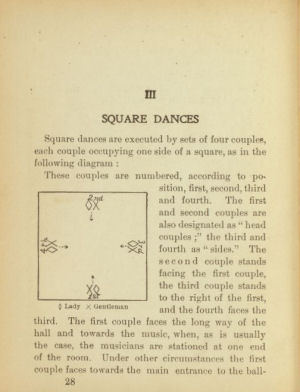
New Jersey State American Folk Dance: Square Dance
Square Dancing 101: Square dancing basic including positions, formations, moves, and a glossary.
Video Square Dance Lessons Online: Video Square Dance Lessons Online and on DVD from Cyberpoint Marketing, LLC.
A Brief History of Square and Round Dancing: by Herb Egender.
Square Dancing: The Historical Geography of an American Folk Custom: by Richard M. MacKinnon, Allan Hancock College, Santa Maria, California.
Square Dance History Project: Website devoted to the documenting the history of square dancing with historical documents and an emphasis on imagery as much as possible..
History and Heritage of Modern American Square Dancing: A summary of the essays by Dorothy Shaw, Bob Osgood and Kenny Reese.
The State Folk Dance Conspiracy: Fabricating a National Folk Dance: by Judy Mangin - Originally published in the Old-Time Herald, v.4(7) p.9-12, Spring 1995.
National Folk Dance Effort Moves Forward: We're On Our Way Now, So Let's Make a Lot of Noise!: United Square Dancers of America National Folk Dance Committee.
The Square Dance Legislation Collection: American Folklife Center 1984/024, Compiled by Michelle Forner, Library of Congress, Washington DC, December 1994
Official website: Northern New Jersey Square Dancers Association, Inc.(NNNJSDA). Square dance information site for the northern New Jersey Area since 1958.
Official website: Square Dance Council of New Jersy (SDCNJ). The Square Dance Council of New Jersey was founded in 1983 to preserve and promote the square dance activity throughout the State and surrounding areas.
Official website: Delaware Federation of Square & Round Dancers.
State dances: Complete list of official state dances from NETSTATE.COM
More symbols & emblems: Complete list of official New Jersey state symbols from NETSTATE.COM.
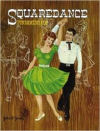
Square Dance Fundamentals
John W. Jones
Square Dance Fundamentals, John W. Jones. 208 pages. Publisher: BookSurge Publishing (February 5, 2007)
While there have been countless fun books written on square dancing, Squaredance Fundamentals was the first to cut to the chase. There is no interesting history of square dancing, there are no entertaining anecdotes, just the nuts and bolts of how to square dance. Revolutionary illustrations show the dancer’s point of view, not just the spectators’ viewpoint. Dancers can, without turning on their heads, glean from the detailed illustrations exactly what they need to be doing with their hands, feet, etc. Each dancer can effortlessly grasp the material and easily retain it. Renown master caller/teacher, Marshall Flippo, assiduously assisted the author in establishing the very first guidelines for standardized “Basic Maneuvers” which would enable square dancers to dance gracefully with any group, anywhere.
No one shows you better how to execute the maneuvers than John W. Jones with his super simplified instructions and state-of-the-art illustrations in Squaredance Fundamentals - the gold standard for over 37 years.
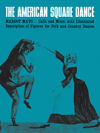
The American
Square Dance
Margot Mayo
The American Square Dance, by Margot Mayo. 116 pages. Publisher:Music Sales American (September 1, 2006)
You can have fun square dancing and you'll learn how to dance the figures and even learn how to call a square dance with Margot Mayo's classic manual, The American Square Dance. Here is the basic book for square dancers containing all of the essentials for many hours of enjoyment. An illustrated glossary of square dance terms shows all of the basic square dance figures – promenade, allemande left, do-si-do, etc. Complete instructions, calls and illustrated figures for 13 of the most popular American square dances appear, plus the music all ready for your pianist and fiddlers to play.
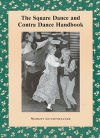
The Square Dance and
Contra Dance Handbook
Margot Gunzenhauser
The Square Dance and Contra Dance Handbook: Calls, Dance Movements, Music, Glossary, Bibliography, Discography, and Directories, by Margot Gunzenhauser. 320 pages. Publisher: McFarland & Company, Inc., Publishers; annotated edition edition (July 28, 2010)
This comprehensive guide to traditional style square and contra dancing, sometimes referred to as "country dancing," covers both music and style and gives background information on various dance types and calling techniques. Ninety dances, presented in chapters according to type (mixers, progressive circles, contra, Southern mountain style, squares and others), in a wide variety of formations are described with drawings and diagrams for many of the movements. A glossary of terms, a directory of addresses (organizations; vendors of books, recordings and audio equipment; and dance camps), and an annotated discography and bibliography are also provided.
A glossary of terms, a directory of addresses (organizations; vendors of books, recordings and audio equipment; and dance camps), and an annotated discography and bibliography are also provided.
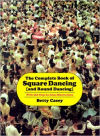
The Complete Book
of Square Dancing
(and Round Dancing)
Betty Casey
The Complete Book of Square Dancing (and Round Dancing), by Betty Casey. 208 pages. Publisher: University of North Texas Press (June 1, 2000)
This book includes: 50 basic movements, 35 advanced movements, variations, dances that are a part of the American heritage, Contra and Round Dances, polkas and reels, and calls, past and present.
“Square dancing is friendship set to music,” says author Betty Casey. Just take four couples, old or young, put ’em on a good floor, turn on the music, and you’re all set. Whether you’ve done it before or you’re just starting out, this book tells you everything you need to know—85 basic movements used all over the world, the spirited calls unique to square dancing, the costumes and equipment that are best, and music (from “Red River Valley” to “Mack the Knife”) that will set your feet in motion.
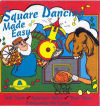
Square Dancing
Made Easy
Square Dancing Made Easy, Grade level: K-6. Audio CD (September 1, 1995), Number of Discs: 1, Label: Educational Activities, Inc.
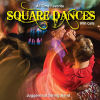
All Time Favorite
Square Dances
All Time Favorite Square Dances with Calls, Audio CD (September 8, 2009), Number of Discs: 1, Label: KADO, Run Time: 60 minutes.
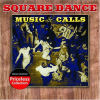
Square Dance Music
& Calls
Square Dance Music & Calls, Audio CD (November 21, 2006), Number of Discs: 1, Label: Collectables Records.
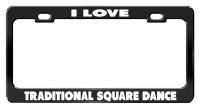
Black Metal
License Plate Frame
I LOVE TRADITIONAL SQUARE DANCE Black Metal Car Accessories License Plate Frame, This high quality license plate frame is made of metal, and it's the best quality item of its kind in the market. The lettering and art work are done by waterproof vinyl on the license plate frame and it will last for many years without any damage. It will not get brittle or cracked. It fits on all USA and Canada vehicles. It measures 12.5" X 6.5" and is durable to last under all weather conditions.
- Heavy Duty High Quality Metal License Plate Frame.
- Perfect Gift idea And Easy Installation.
- Rust, Corrode And Fade Free For Many Years.
- Fits all US and Canada License Plates.
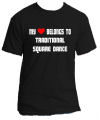
Traditional Square
Dance T-Shirt
MY HEART BELONGS TO TRADITIONAL SQUARE DANCE, This is a high quality pre-shrunk t-shirt that will not shrink or fade. It's comfortable, casual and loose fitting and will quickly become one of your favorites. It wears and looks well on anyone. It is cured with a heat treatment process to ensure lasting durability.
Brand New High quality preshrunk tee-shirt that will not shrink or fade. Double-needle stitched hemmed sleeves and bottom. Highest quality printing materials. 50% Cotton, 50% Polyester preshrunk blend. Soft, comfortable and weighs 6 oz.
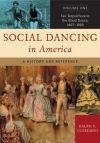
Social Dancing in America: A History and Reference (Volume One), by Ralph G. Giordano. 380 pages. Publisher: Greenwood (November 30, 2006)
Social Dancing in America examines the role of social dancing in daily life from the first settlements in 1607 through the birth of the nation in 1776 and into the beginning of the 21st century. This two-volume set provides a history of American social dances including the Virginia Reel, Square Dancing, the Lindy Hop, Rock 'n' Roll, the Twist, Disco, Breakdancing, and Hip-Hop. Social Dancing in America places social dancing in a historical, social, cultural, and political context.
Volume 1 explores the integral role that social dancing played in the lives of Americans from the first settlements in 1607 through the 19th century, often in the most unlikely of ways. For example, readers may be surprised to learn that George Washington was a well-known aficionado of social dancing, and that he incorporated the etiquette and manners of dances such as the Minuet as a means of diplomacy to secure European allies during the Revolutionary War. After his death, Americans continued to celebrate his birthday with a grand ball that included dancing.
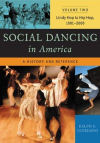
Social Dancing in America: A History and Reference (Volume Two), by Ralph G. Giordano. 428 pages. Publisher: Greenwood (November 30, 2006)
Volume 2 places social dance in a 20th-Century context, illustrating how social dancing itself paralled the social, economic, and cultural traditions of each era. For example, segregation and the Jim Crow mentality was cemented in place all over the United States, and for much of the century, dancing and dance halls were strictly segregated. Segregation forced a mass migration north, and with it came the transformation of Delta Blues music into an American original—Jazz. Jazz gave birth to the Charleston, and later evolved into Swing, which created the Lindy Hop. Later, with the advent of television, programming such as American Bandstand, Soul Train, Dance Fever, and MTV greatly influenced dance styles and modern trends such as Rock 'n' Roll, Freestyle, Disco, Breakdancing, and Hip-Hop.

